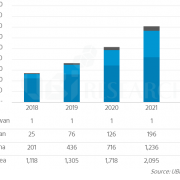On November 5, during the 16th Merck Display Insight 2015 seminar, Merck revealed the development results for solution process materials. The solution process materials presented were red and blue materials’ efficiency, lifetime, and CIE.
At present UDC’s evaporation materials are being used in OLED mass production. UDC’s evaporation material performance, published on the company website, were compared with Merck’s materials. Merck’s red material’s efficiency was 19.1cd/A, lifetime was 5,900 hours, and the CIE was (0.66, 0.34) which were approximately 66% of UDC material’s efficiency (29cd/A), 26% of UDC material’s lifetime (23,000 hours), and showed equal CIE.
For Merck’s green material, efficiency was 76.4cd/A, lifetime was 5,200 hours, and the CIE was (0.32, 0.63). These were approximately 89% of UDC’s green’s 85cd/A of efficiency, and 29% of 18,000 hours of lifetime. The CIE were similar with UDC’s (0.31, 0.63).
The comparison of the published materials’ performance, efficiency of solution process materials are developed to the similar levels as evaporation materials, but material lifetime require more research. Through this seminar, Merck revealed that the LT95’s solution process material’s lifetime will be solution process OLED’s most crucial challenge.
During the question and answer part of the poster session, Merck also revealed positive outlook that full stack solution process OLED product will be produced within the next 3-4 years.
Despite being one of the latecomers within the OLED material business, Merck is producing notable results in solution process material development and OLED material sales. This year’s sales results are anticipated to be higher than expected.
According to 2015 Solution Process OLED Annual Report, published by UBI Research, the key issue for solution process OLED is solution process emitting material performance. The solution process red and green’s efficiency reached to the similar levels as evaporation material. However, lifetime showed to be ≤approx. 30% of evaporation material in LT95. On the other hand, solution process blue is analyzed to be falling behind evaporation material in both lifetime and efficiency. As such, it is estimated that solution process OLED will be mass produced using the hybrid structure where red and green are formed through printing, and blue is formed through evaporation.

























